On the 10th anniversary of Rip It Up the magazine looked through its back pages for its coverage of New Zealand music. The first 101 issues – from 1977-1985 – can now be read online at Papers Past.
June, 1977: In America, Elvis Presley gives his final concert. In London, police raid a Sex Pistols gig and Johnny Rotten is slashed by a knife-wielding fan. In Wellington, PM Muldoon begins to assert his power with a controversial SIS bill and a National Party old boy for Governor-General.
In Auckland, small bundles of a new music paper modestly called Rip It Up appear on record shop floors.
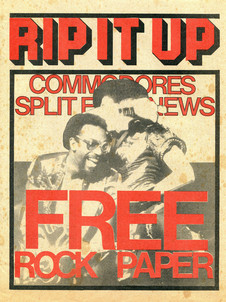
Rip It Up No.1, June 1977.
And so, in 1987 – a year of anniversaries – it’s Rip It Up’s turn. On the cover of that first issue, FREE ROCK PAPER in giant letters all but obscured the blurry black-and-white picture of the Commodores. Ten years later, that claim seems taken for granted, but even more extraordinary.
Inside, news of the latest Sex Pistols exploits were given equal space with changes in 10cc’s line-up. For despite what its critics – and fans – might have once thought, RIU was never exclusively a punk paper. From that Commodores cover on issue No.1 to Ardijah on No.119, all a music paper can really do is reflect the spirit of its age, and hopeful encourage the best of what’s available.
From the beginning, that has meant a large proportion of New Zealand content. To those growing up watching television and listening to the radio in the mid-70s, ignorant of Hot Licks and Split Enz, it seemed the only local music about was John Hanlon and Mark Williams. Rip It Up featured Williams on the cover of its second issue, “How a No.1 Record Doesn’t Solve All Your Problems”, but the magazine’s New Zealand commitment was made easier with the swift growth of live bands and records in the wake of Hello Sailor and the DIY punk ethic.
The first issue brought news of the Hello Sailor debut album and the opening of a “new style” of venue, the Island of Real – two significant moments in our recent musical history. Plus, news that Split Enz had recruited Neil Finn: “A very talented young lad,” wrote Eddie Rayner, “only 18 years old, who we are going to mould and lovingly shape.”
At least half-a-dozen waves can be determined by reading 10 years of Rip It Up. While the early issues seemed like a continuation of Hot Licks, with their championing of Split Enz and Little Feat, they also reflect the conflict in the change to the new order. Rough Justice and Schtüng would have to move over for the Scavengers and the Suburban Reptiles. For me, the pivotal moment of transition was the day Auckland’s art school punks came to Wellington – in August, 1977 – when the pseudo-Pistols (the Reptiles) obliterated the act on before them: the pseudo-Santana of Living Force.

Auckland punk concert reviewed by Mike Chunn, August 1977.
But what was punk? RIU cub reporter Mike Chunn asked Billy Planet of the Suburban Reptiles. “I don’t know,” he said. “The Sunday News seems to know what punk is.” Jeremy Templer wrote in RIU 5: “While punk rock has undoubtedly been accepted as part of a reaction against the mechanical discipline of disco music, its importance lied in its emergence as a marketable fashion. Its password is a surrender to primalism. But this could be the early 60s: the music is once more outrageous, but it’s also antagonistic, creating its own tension, dividing, sometimes conquering. And the kids are excited.”
First of all, however, punk had to usurp disco, and it was two years before the beast was fought off. As with any genre, disco had its moments, but the monster seemed so gross at the time, it was difficult for the uninitiated rock fan to hear them. “I certainly would not knock an album because mention is made of that five-letter word disco, or because I cannot boogie,” Murray Cammick bravely admitted in issue five.
By September 1978, 140,000 New Zealanders had bought Saturday Night Fever, and RIU succumbed with a disco special. Francis Stark entered the Double M Disco (called Abby’s in 1987) for a piece of social anthropology. “The object doesn’t seem to be to dance – instead the people are there to practice social mobility … At the heart of the crowd are those who look they are waiting for Central Casting to call them up for their role in Is It Wednesday Yet?” Writers and musicians picked their disco favourites. Harry Lyon ‘Disco Duck’, William Dart ‘Macho Man’, Duncan Campbell ‘Flashlight’. Stark picked the ubiquitous ‘Boogie Nights’ – “I started out putting it on juke boxes to any hippies and grew to love it. I even learned the actions off the TV clip.”
Despite many live venues turning to discos (a never-ending battle, it seems) by early ’78 an upturn in the live scene was noticed. “Auckland is beginning to fill up again with working bands. Hello Sailor probably started it … going to the pub means more than showing off your new jeans and halter top.”

Split Enz: a live review by George Kay, April 1979.
As with any music mag, RIU has had it series of great Kiwi hopes: Split Enz, Sailor, Citizen Band, Toy Love, Swingers, Screaming Meemees, Newmatics, through to Dave Dobbyn, the Chills and Ardijah, as well as overseas favourites: Elvis Costello, Springsteen, and especially Graham Parker. And the tone could turn bitter when radio stations or record companies didn’t show the same enthusiasm. “In Christchurch, 3ZB broadcast a ‘live’ Graham Parker show at the same time as the concert, advertised as ‘If you can’t afford the real thing.’ So you can see what we’re up against with radio in this part of the woods” … “Did you hear about Polygram flying 80 people around in a DC10 to promote the new Bee Gees album? [Spirits Having Flown] What’s wrong with recording a local band instead and let the Bee Gees sell themselves?”
The local band scene got off the ground so quickly that, in a pivotal issue (No.21), five new bands were featured on the cover (“Name the band members and WIN a night at home with yourself!”): Toy Love, Johnny and the Hookers (“They dislodged fillings at 20 paces, toupées at 50” – Terence Hogan), the Terrorways, Gary Havoc and the Hurricanes, and Sheerlux.
RIU sponsored a “Meet the Boys” night in which the band members discussed the scene. It was like a mutual admiration society, though Sheerlux, absent from the meeting, received some flak: “Bands like Sheerlux don’t have magic,” said Chris Knox. “They can do conjuring tricks, but it’s all to a formula. Mixes are an even better example. Steve Gilpin has even admitted that he just looked around for what was happening and then did it. If it had been jazz-rock then he’d be into that now.”

Toy Love play Auckland's Windsor Castle, reviewed by Dominic Free, February 1979.
Knox was an identity from his earliest gig with the Enemy (whose debut gig was reviewed in No.7 by Roy Colbert). In the same issue as Toy Love’s first review appeared (“Furious promise”) was a curious letter by “Mrs McLean” of Otahuhu: “How can you promote this obscene rubbish [the Enemy] when your pages could be devoted to all the wonderful talent we have in this lovely country, like Toy Love and John Hore.” Very soon, Knox wouldn’t have to write letters to gain attention.
The new era had taken hold. In May 1979 Peter Kennedy of Rough Justice spoke for many when he said, “Twelve months ago we were considered ragers. Now they think we’re laid back. That’s punk rock, I suppose. But what can we do? None of us are into new wave.” Barry Jenkin, who in issue three had prescribed Little Feat and Steely Dan (“There’s not a hell of a lot to English punk rock, with its chord after chord”) was now a cult hero as Dr Rock.
In late ’79 Roy Colbert observed Toy Love’s triumphant return to Dunedin: “Knox asks the crowd if they’d like to know about the Auckland scene. Derision drowns him out. He sticks a safety pin in his cheek.”
By that time, Toy Love had received a rave review from the NME for their explosive debut ‘Rebel’/ ‘Squeeze’. At home, critics had stopped reviewing local records apologetically long before, and by 1980 the era of the single was underway.
Although that was the year that Hello Sailor, Th’ Dudes and Toy Love split, the live scene was booming (a 50-metre queue for a Street Talk Gluepot gig – by 6.30pm!) and an extraordinary number of 7” gems were released (plus MP Marilyn Waring’s cover of Lennon’s ‘Working Class Hero’). In May alone, the singles column reviewed The Swingers’ ‘One Good Reason’, Toy Love’s ‘Don’t Ask Me’, The Crocodiles’ ‘Tears’, Graham Brazier’s ‘Six-Piece Chamber’, Th’ Dudes’ ‘Bliss’, Street Talk, the Terrorways (on Ripper), Spelling Mistakes’ ‘Feel So Good’, Features’ ‘City Scenes’ – the latter two on new indie Propeller, which was to prove a key element in the next wave.
It had been predicted as far back as July 1979 when a letter from the North Shore said, “RIU, you’re all old men. You don’t believe young bands can do it, do you? … Well us young bands are coming! (PS: I’ll drop into the RSA next month and help ya with the next issue.)”
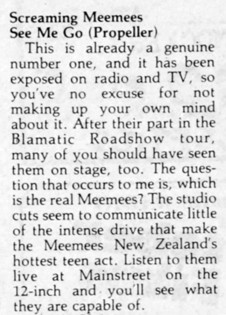
Screaming Meemees' No.1 hit reviewed by Francis Stark, September 1981.
Appropriately, the first mention of the Screaming Meemees, in November 1980, was when they were co-billed at the Spelling Mistakes’ final gig at XS. “On that note,” wrote Karen Stevens, “ended the last of the second wave of punk bands. You gotta move with the times … The Meemees dislike labels, but agree to having their music described as post-beat psychedelia. Screaming Meemees are moving with the times.”
By the next issue, the Propeller wave had started: Blam Blam Blam were pictured, and the Newmatics came third (to Hattie and the Hotshots) in the Battle of the Bands. Mark Phillips, reviewing Decembers North Shore Spectacular at XS, wrote: “Auckland’s North Shore is rapidly becoming the city’s new mecca for aspiring young bands. The Meemees are rapidly developing a following that could see 1981 being their year. It’s not hard to see why they’ve become the darlings of the North Shore set.”
In the 1980 readers’ poll, the Toy Love album put Split Enz’s True Colours in second place.
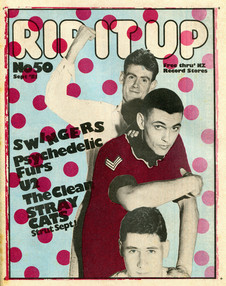
Rip It Up No.50, Sept 1981.
Mid ’81 saw The Swingers’ ‘Counting the Beat’ being the fastest No.1 in Australia since ‘Daddy Cool’ in 1971, and Dave Dobbyn’s Divers playing the Rumba bar. “After ‘Lipstick Power’, could fame be on its way?” In September came the first mention of Flying Nun, with a review of The Clean’s ‘Tally Ho’ in the same singles column as the Meemees’ No.1 hit ‘See Me Go’. Alongside early Toy Love, wrote Francis Stark, ‘Tally Ho’ made a case for “Dunedin as New Zealand’s home of the pure pop melody”. ‘Tally Ho’, wrote Roy Colbert in an accompanying feature, “cost $50 to make and it sounds a bit that way.”
Propeller, meanwhile, was peaking with the Screaming Blam-matic Roadshow and RIU’s first colour covers, made possible by the “I’d love a beer” campaign and Jim Beam. In Dunedin, said George Kay, “The Chills showed Penknife Glides and Danse Macabre the value of good songs over professional presentation.” An alternative criticism was levelled by Don Mackay, when discussing the professional if derivative Australian bands at Sweetwaters 1982. While New Zealand bands had superior material, they “have gotten too head up the bum about credibility and artiness, and unless they recapture the art of showmanship they will have their home market stolen from under their noses.”
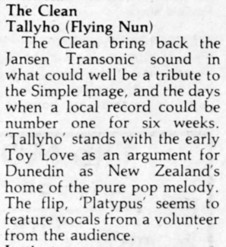
The Clean's Tallyho reviewed by Francis Stark, September 1981.
More New Zealand bands than ever were touring, but in March 1982 grim days were being predicted for the new-found “industry”. Murray Cammick: “The last few years in Auckland rock and roll have been a lot of fun and many have grown accustomed to getting their live music highs in sweaty pubs listening to neat New Zealand songs. Going to Logan Campbell Centre to watch the often tired, perfunctory performances by visiting stars can be tedious work compared with the privilege of being there as good songs are knocked into shape by one of several of the best local bands. So why are so many people saying, “It’s not exciting anymore?”
Among the reasons mooted was Propeller’s (eventually crippling) shift from singles to albums and, that age-old problem, “No innovative young bands are coming through because there are no underage venues,” said Propeller’s Simon Grigg. “The Auckland scene will be in a sorry state by later this year if no inventive bands emerge.”
The answer conveniently arrives at the next issue (April ’82): a South Island special by Michael Higgins, with The Clean on the cover. “Auckland is very quiet,” said Doug Hood. “There are one or two interesting young bands but it seems to be very stagnant. Whereas it seems to be the opposite in the South Island. It seems to be thriving, it’s great.” With the now-legendary TEAC reel-to-reel, Hood and Chris Knox had just recorded the four-band Dunedin Double EP. “For the Clean,” wrote Higgins, the Enemy are the past in Dunedin. They got things moving. Other exports, Mother Goose and the Knobz, are embarrassments and best left unmentioned.”
Rip It Up was now five years old; Herbs’ ‘French Letter’ and the Dance Exponents’ ‘Victoria’ were released, and Russell Brown made his entrance reviewing a Clean/Exponents double bill: “The Clean are not entertainers, they play pop music without smiling. The Dance Exponents are entertainers. Rock and roll clichés sit under them like platform heels. They could step down from them and still be the Dance Exponents.”
Longevity, said Eddie Rayner and Andy Narc in RIU 60, was the key; Split Enz were on that cover, and Graham Brazier and Harry Lyon, making a comeback as the Legionnaires, on the next. The Certain Bar disco was attracting Auckland’s new romantics; there were still two dozen major local bands for Sweetwaters ’83. Murray Cammick – reviewing the Tall Dwarfs’ ‘Louie Likes His Daily Dip’ – said “Chris Knox is doing more with four tracks than those with 20 more.”
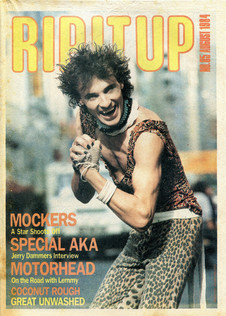
Rip It Up No.85 Aug 1984.
Whereas once Rip It Up had to make do with cover stories from press conference interviews, or worse, cut and paste essays, now it was offered exclusives: Marianne Faithfull, Joni Mitchell, Malcolm McLaren, Talking Heads. Locally, people began to talk about capturing a “New Zealand sound” – “In a year of much talk of indigenous music and Pacific culture, Diatribe and Herbs pay more than lip service.” George Kay awarded 1983’s “Best Con” as “A tie between the Narcs, Auckland Walk, all Wellington bands (except the Pelicans), Coconut Rough, Legionnaires.” ’Arry, in-house satirist, awarded Russell Brown – who in his 12 months as assistant editor/staff writer had already made quite an impact – the Special “I Brought Foot and Mouth from Timaru to Auckland” Shield.
By 1984 the touring circuit had stagnated and the Party Boys introduced a safe concept that was to be well-milked in the coming years by the likes of the Kuhtze Band: old faces, old songs. But Looney Tours mounted an ambitious “End of the World Before It Happens” package tour featuring The Chills, Childrens’ Hour, The Double Happys and The Expendables. Also, New Zealand had its two biggest pop idols since the 1960s: 3000 people attended The Dance Exponents’ “farewell” show at Logan Campbell with the Mockers.
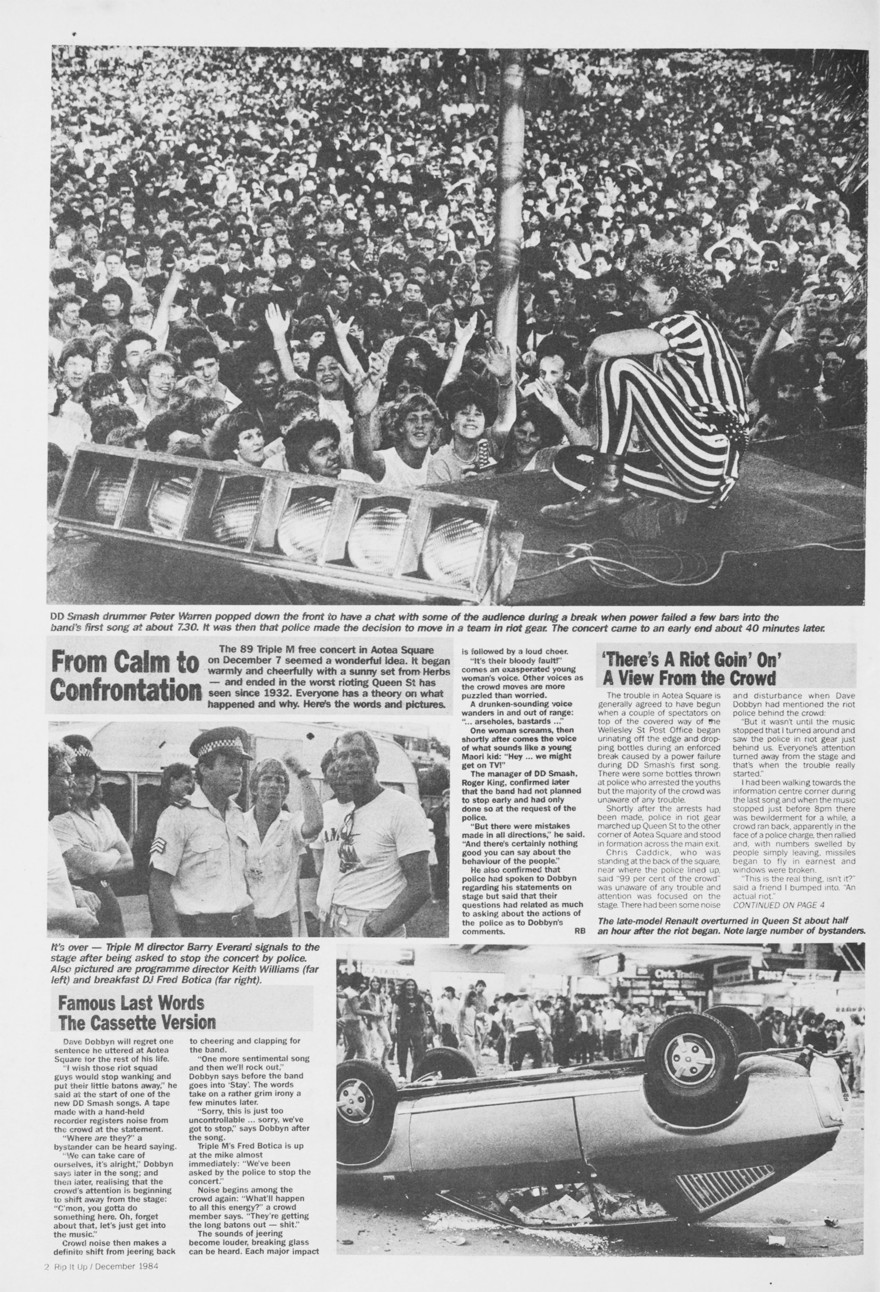
Rip It Up reports on the Queen St riot, December 1984.
The issue I feel Rip It Up can be proudest of came out that December, after the Aotea Square debacle. With just three days till the magazine went to press – and after a very late night – Russell Brown produced the most objective, honest account of the evening when police and punter ran riot. While other papers hysterically looked for sociological causes, RIU printed a half-page photo by Bryan Staff of a peaceful crowd, taken the moment the police moved in.
In a side-bar, “Famous Last Words”, a transcript taken from a Walkman recording (by Ron Kane, New Zealand music fan from Los Angeles) of the concert gave a gripping account of the run of events: “Dave Dobbyn will regret one sentence he uttered at Aotea Square for the rest of his life. ‘I wish those riot squad guys would stop wanking and put their little batons away.’” He then tried to encourage the crowd to ignore the disturbance at the back, and keep on enjoying the music. When the music was stopped, people turned around and noticed the riot police – and a little disturbance turned into a riot.
“The whole sorry incident could have been avoided in one way by, as has been suggested, the banning of alcohol at the concert. But to many who were there, the disorder would not have escalated if police conduct had been sensitive and appropriate to the overwhelmingly peaceful mood of the concert. Coming up the middle of Queen St and assembling across the main exit from the Square was akin to setting themselves up as pins in a bowling alley. Some of the crowd simply took up the challenge.”
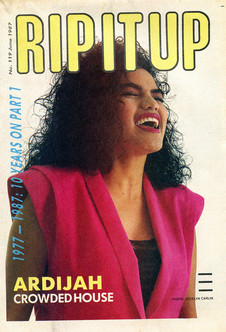
Betty-Anne Monga of Ardijah on the cover of Rip It Up's 10th anniversary issue, June 1987 - photo by Jocelyn Carlin.
The RIU writers’ favourite local records that year were The Verlaines’ ’10 O’Clock in the Afternoon’, The Chills’ ‘Pink Frost’ and Herbs’ ‘Long Ago’. Auckland alternative bands, wrote Brown, were taking initiatives to dispute “the only place where anything is really happening is Dunedin syndrome. Some of these bands are really happening – they just need to be taken seriously.” “Those Who Are In It For The Money,” he said, were beginning to take an interest in The Chills.
Eighteen months on from the 100th issue, the perennial difficulties still face local music: lack of venues, alternative and underage; a general public which seems disinterested in New Zealand music, or condescending, thanks to an unsupportive radio industry; and few innovative young bands emerging.
Nevertheless, despite the ebbs and flows since 1977, there is plenty to be positive about: international is beginning to happen through Crowded House, Dave Dobbyn, The Chills, and Flying Nun’s export strategy. Radio shows some signs of discovering local music, and hopefully a flow-on effect will stimulate the young musician. There’s no “movement”, as such, but plenty of movement.
“‘Being in a band’ is still a helluva good thing,” wrote Russell Brown in 1985, “like the modern-day equivalent of running off to join the circus. And when you set your sights on the stars and then begin to make some progress towards them, it’s an adventure.”
For 10 years Rip It Up has been part of that adventure.
--

Murray Cammick and Ngila Dickson, Le Bom, Auckland, July 1987.
First published in Rip It Up, June 1987, to mark the magazine’s 10th birthday. At the time Murray Cammick was also publishing the pop magazine Shake! (which he edited), and fashion magazine Cha-Cha (edited by Ngila Dickson, who would become an Academy Award-winning costume designer). Murray and Ngila are pictured here at the 10th birthday party, Murray wearing a one-off “120 Deadlines” sweatshirt designed by Snake Studios. Chris Bourke contributed to Rip It Up from 1983 to 1997, and was the editor from February 1986 to August 1988.